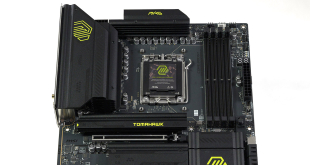The black and blue colour scheme that Asus have used for the M4A87TD looks great and should fit in well aesthetically with most setups. There are quite a few noticeable differences between this board and the M4A89GTD Pro that we looked at recently including its narrower form and lack of any heatsinks on the voltage regulation circuitry.
One way in which Asus have cut costs compared to the M4A89GTD Pro is by using the AMD 870 chipset instead of the 890GX. This doesn't have an onboard GPU so you must have a discrete graphics card for your system. But we can't imagine that this would be a problem for the majority of our readers as they will require more power than an onboard GPU has to offer.
Asus have only included a single full length PCI Express lane on the M4A87TD so Crossfire is not supported on this board. This lane runs at x16 and is accompanied by PCI Express x1 and x4 slots on either side. There are also three legacy PCI lanes for those who require them.
Even though the M4A87TD is narrower than the M4A89GTD, Asus have retained the same distance between the CPU socket and RAM by moving the 24-pin power connector further down the board. This should provide room for most CPU coolers although larger ones will still obstruct the RAM slots. There are four slots in total which support up to 16GB of 1600MHz ram (2000MHz OC).
In the bottom right hand corner of the motherboard we find the six SATA 6Gbps ports. These are all attached vertically on the motherboard which makes it difficult to manage cables as neatly as you can with perpendicular connectors. The IDE connector has been shifted up the motherboard next to the RAM slots.
The included selection of rear panel I/O connections should be sufficient for most users. Although the connections seem a lot less plentiful than those on the M4A89GTD, this is largely in part due to a lack of display outputs. The connections consist of two PS/2 connectors, 6 USB2.0 ports, 2 USB3.0 ports, an RJ-45 ethernet jack and three 3.5mm audio jacks.
 KitGuru KitGuru.net – Tech News | Hardware News | Hardware Reviews | IOS | Mobile | Gaming | Graphics Cards
KitGuru KitGuru.net – Tech News | Hardware News | Hardware Reviews | IOS | Mobile | Gaming | Graphics Cards









What a stunning price. I know a lot of people never use dual graphics solutions so this is more than ideal.
Good feature set and great price, always buy asus boards meself.
Asus and MSI make the best mobos on the market, bar none
The only downside is the sata ports pointing upwards. bad design decision in 2011, even on a budget board.
Very solid looking board, shame about the sata design, thats rather unusual for asus even on a budget model.
Great stuff. ideal for a low cost performance system.
Finally, a motherboard most people can afford !
have this board SATA 3.0 ?